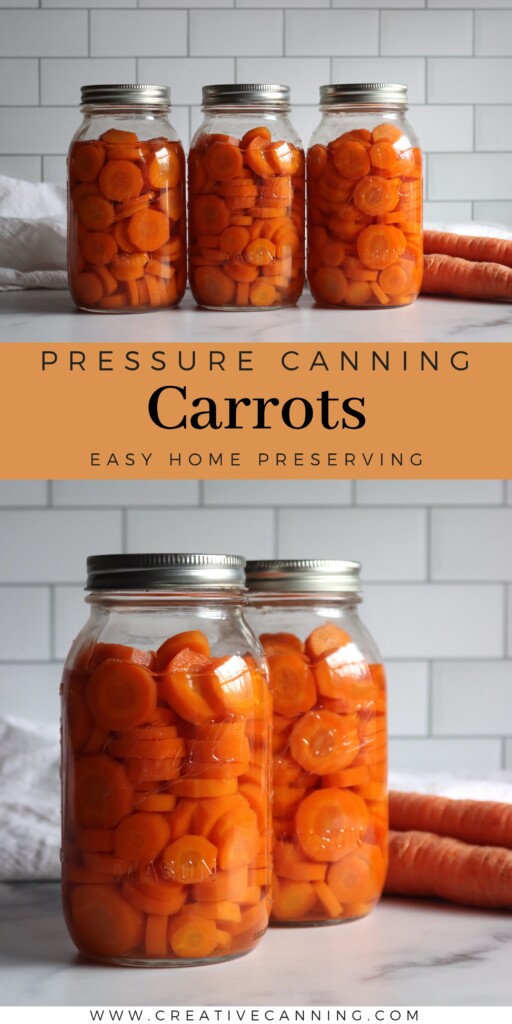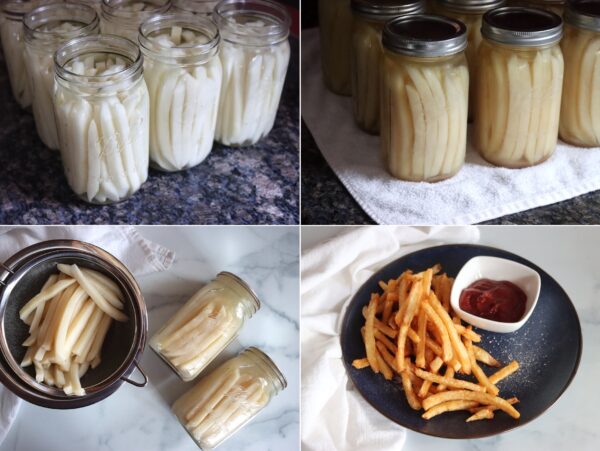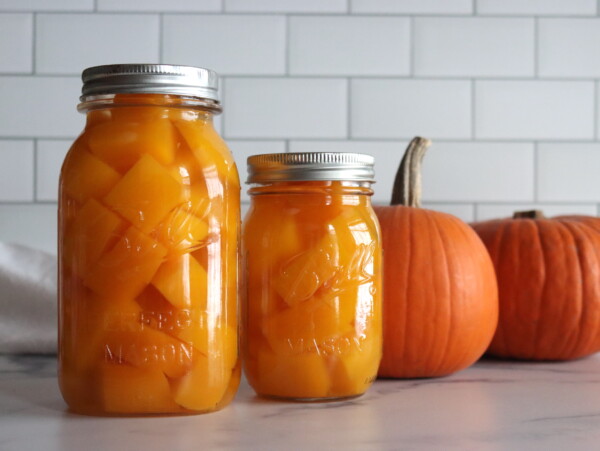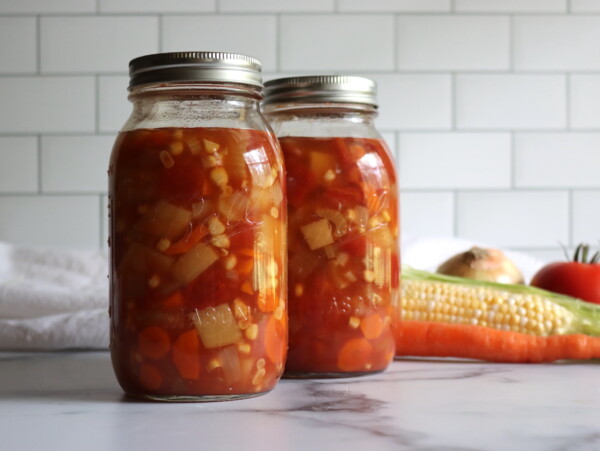This post may contain affiliate links. Please see our disclosure policy.
Canning carrots is an easy way to preserve this sweet summer vegetable for shelf-stable meals all year long. Whether you raw pack or hot pack, pressure canning keeps them ready for soups, stews, casseroles, or simple side dishes. It’s a practical way to save time in the kitchen and make the most of your harvest.

Carrots are one of the simplest vegetables to pressure can, and they’re surprisingly handy to have in the pantry. Whether you grow your own or pick them up in bulk at the market, pressure canning carrots is a great way to preserve a reliable staple that’s ready to use straight from the jar—no peeling or chopping required when you’re in the middle of making dinner.
We can carrots every season, and they’re one of those jars we actually use. They go into soups and stews, get mashed with butter for a quick side dish, or even tossed into a casserole without any prep. Since carrots are a low-acid vegetable, they need to be pressure canned for safety, but the process is straightforward. You can pack them raw or hot, add a little salt if you like, and preserve them in water or broth.
This method follows USDA-tested guidelines for pressure canning carrots in pints or quarts, so you can stock your shelves with confidence.
Why Pressure Canning?
Carrots are a low-acid food, which means they must be pressure canned to be preserved safely. Water bath canning isn’t safe for carrots, even if you add vinegar—they don’t have enough natural acidity to prevent the growth of botulism unless processed at high pressure.
Pressure canning brings the internal temperature of the jars high enough to safely preserve low-acid vegetables like carrots, green beans, potatoes, and beets.
Preparing Carrots for Canning
Start with fresh, firm carrots—either from your garden or the store. Wash them thoroughly and peel them to remove dirt and any bitterness from the skin. You can slice them into rounds, dice them, or cut them into sticks, depending on how you plan to use them later.
You can raw pack or hot pack carrots for pressure canning. Both methods are tested and safe; it just depends on your preference and how much prep time you have.
- Raw pack means you pack raw carrots directly into jars and pour hot water over them. It’s quick, but the carrots can float or shrink slightly.
- Hot pack means you simmer sliced carrots for 5 minutes before packing. This helps remove air from the tissues and results in a tighter pack.
What Size Jars Should I Use?
You can use pint jars or quart jars for pressure canning carrots. Pints are great for smaller households or recipes that only need a cup or two of carrots, while quarts are ideal for big-batch cooking or meal prep.

How to Pressure Can Carrots (Step-by-Step)
Before you start, get your pressure canner set up. Wash your jars, lids, and bands in hot soapy water, and keep the jars warm until you’re ready to fill them. Add a few inches of water to the canner and begin heating it on the stove, keeping it just below a simmer (about 180°F).
Next, prepare the carrots by washing and peeling your carrots.
Always peel root vegetables for canning! This is required for canning safety, as microbes in garden soil are no good in canning jars. Anything that’s had soil contact needs to be peeled away before canning, but that’s easy enough with a veggie peeler.
You can slice them into rounds, dice them into chunks, or cut them into sticks depending on how you plan to use them later.
If you’re choosing to hot pack, simmer the sliced carrots in boiling water for about 5 minutes to help remove air from the tissue, which can result in better texture and a tighter pack in the jar. For raw pack, you can skip the simmering step and go straight to packing.
Pack the carrots into jars, leaving 1 inch of headspace at the top. If you’d like to add salt for flavor, you can include ½ teaspoon per pint or 1 teaspoon per quart, but this is completely optional and doesn’t affect safety.
Pour boiling water or broth over the carrots, maintaining the 1-inch headspace. Use a bubble remover or a non-metallic utensil to remove any trapped air bubbles, and top off with more liquid if needed to adjust the headspace.
Wipe the rims of the jars with a clean, damp cloth to ensure a good seal. Place the lids on the jars and screw the bands down until they’re fingertip tight. Load the jars into your pressure canner, spacing them evenly so water and steam can circulate.
Lock the canner lid in place and turn the heat to high. Once a steady stream of steam is escaping from the vent, allow it to vent for 10 full minutes. After that, close the vent and let the canner come up to pressure. You’ll process pint jars for 25 minutes and quart jars for 30 minutes, adjusting for altitude as needed (see chart below).
When the processing time is up, turn off the heat and let the canner cool naturally until the pressure drops back to zero. Don’t try to speed up this process—just be patient. Once the pressure is completely down, wait about 5 more minutes before opening the lid carefully, facing it away from you to avoid steam burns.
Use a jar lifter to carefully remove the jars and place them on a towel-lined counter. Let them cool undisturbed for 12 to 24 hours. After they’re completely cool, check the seals by pressing the center of each lid. If it doesn’t flex, the jar is sealed properly. Label your jars and store them in a cool, dark place.
Any unsealed jars should be refrigerated and used within a week. Properly sealed jars will last at least a year on the shelf.
Pressure Canning Altitude Adjustments
With pressure canning, the processing times stay the same at higher altitudes, but the pressures change. Here are the altitude adjustments for pressure canning:
For dial gauge pressure canners:
- 0 to 2,000 feet in elevation – 11 lbs pressure
- 2,001 to 4,000 feet in elevation – 12 lbs pressure
- 4,001 to 6,000 feet in elevation – 13 lbs pressure
- 6,001 to 8,000 feet in elevation – 14 lbs pressure
For weighted gauge pressure canners:
- 0 to 1,000 feet in elevation – 10 lbs pressure
- Above 1,000 feet – 15 lbs pressure
Canning Liquid
Carrots are usually canned in plain boiling water. Salt is optional—many people like to add ½ teaspoon per pint or 1 teaspoon per quart, but it’s not required for safety.
You can also process home canned carrots with a bit of sugar, and I’ve seen recipes that include ½ cup of pineapple juice and ¼ cup of maple syrup in the canning liquid for a quart jar. It gives you a sweet tropical glazed carrot when you reheat them with a bit of butter.
You can use soy sauce, orange juice, pineapple juice, sugar, brown sugar or maple syrup along with water if you want a bit more flavor. The canning time is not sufficient for canning in meat stock or veggie broth, so stick to water or acidic fruit juice as the canning liquid, plus salt and/or sugar or your choice.

Canning Carrots
Equipment
Ingredients
- Fresh carrots, about 2 pounds per quart jar
- Boiling water
- Canning salt, optional
Instructions
- Prepare Jars and Canner: Wash jars, lids, and rings. Heat jars in warm water and bring water in the pressure canner to a simmer (180°F).
- Prepare Your Carrots: Wash and peel fresh carrots. Slice into rounds, dice, or cut into sticks.
- Prepare for Packing Jars: For hot pack, simmer carrots in boiling water for 5 minutes. For raw pack, skip simmering and pack directly into jars.
- Pack the Jars: Fill jars with carrots, leaving 1 inch headspace. Add ½ tsp salt per pint or 1 tsp per quart, if using. Pour boiling water or broth over the carrots, maintaining 1 inch headspace.
- Remove Air Bubbles and Seal: Use a bubble remover to release any trapped air. Adjust headspace as needed. Wipe jar rims clean, apply lids, and screw on bands until fingertip tight.
- Process in Pressure Canner: Place jars in the canner. Lock the lid and vent steam for 10 minutes, then bring to pressure. (See notes for pressures based on altitude.) Once at pressure, process pint jars for 25 minutes and quart jars for 30 minutes
- Cool and Store: Allow pressure to return to zero naturally. Wait 5 minutes, then open the lid. Remove jars and let cool undisturbed for 12–24 hours. Check seals. Store in a cool, dark place for up to 12–18 months. Refrigerate after opening.
Notes
Pressure Canning Altitude Adjustments
With pressure canning, the processing times stay the same at higher altitudes, but the pressures change. Here are the altitude adjustments for pressure canning: For dial gauge pressure canners:-
- 0 to 2,000 feet in elevation – 11 lbs pressure
-
- 2,001 to 4,000 feet in elevation – 12 lbs pressure
-
- 4,001 to 6,000 feet in elevation – 13 lbs pressure
-
- 6,001 to 8,000 feet in elevation – 14 lbs pressure
-
- 0 to 1,000 feet in elevation – 10 lbs pressure
-
- Above 1,000 feet – 15 lbs pressure
Nutrition
Nutrition information is automatically calculated, so should only be used as an approximation.
Pressure Canning Recipes
If you’re building your pantry with shelf-stable veggies, try these pressure canning recipes next:
- Pressure Canning Potatoes – A great base for soups, stews, or home fries.
- Canning Green Beans – Crisp-tender beans ready to use straight from the jar.
- Canning Sweet Corn – Sweet and easy to use in chowders or casseroles.
- Canning Vegetable Soup – A full meal in a jar with garden-fresh flavor.
- Canning Carrot Soup – A smooth, blended soup that is another great way to preserve carrots in a jar.





I make a batch of these every few months for my son who loves simple cooked carrots. They’re delicious and perfect as a heat and eat side dish. The main thing here is you have to choose hardy storage carrots as those taste the best and hold their shape after canning. Don’t use those tender summer carrots, they fall apart in canning.